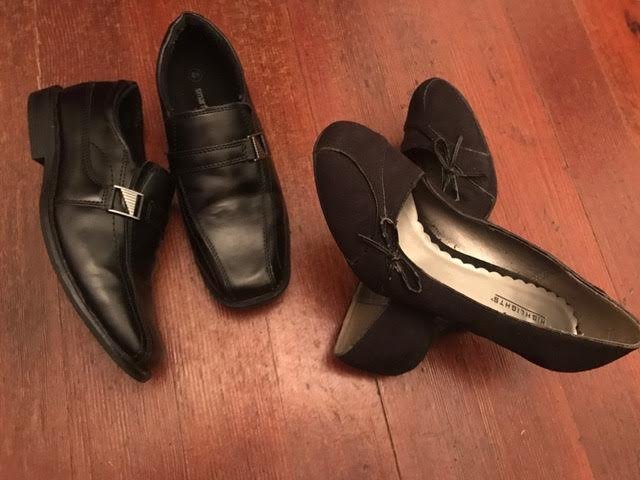
My daughter Mollie, who is 15, needed a pair of dress shoes for a formal band concert. She had black slacks, a white button-down shirt and vest (even tie) but she needed shoes. I suggested black ballet flats but she wanted black loafers from the boys’ section. Without thought, I said no. We fought, we cried, and she asked me, “Why have you always encouraged me to be myself if you were going to stop now?”
I was stunned by the question and had to take a long look at myself – and my parenting behavior – to understand why I had reacted that way.
When Mollie was small, I loved to dress her up in pretty dresses with lots of pink and red. As she got old enough to articulate what she liked, there was no more pink, and her preferences became baggy boy pants and superhero or wrestling t-shirts. I missed the cute, little girl look but enjoyed her freedom in expressing herself. I assumed that as she hit puberty and her body changed, she would start to embrace a more feminine look.
But she didn’t. As she entered middle school and even this year, her second year of high school, she clung to the same styles she’d been wearing for years. Well-meaning friends and family members would broach the subject with us, offering to buy her “more feminine” outfits. She always declined and asked that people respect her preferences.
One of the consequences of her appearance was that she was often mistaken for a boy. It was something we discussed and she understood that people make assumptions based on what they see. She was never bothered when other kids thought she was a boy but she didn’t understand why adults were quick to identify her as such. “They should know that a person isn’t their haircut,” she told me and I agreed. It never occurred to me to look deeper into myself and address how I felt about my daughter who didn’t “look like a girl.”
I didn’t completely understand her choice and wondered if part of her decision was about sexual preference or gender identity. But I always believed that as a parent it wasn’t my job to mold my child into who I wanted her to be, but rather to let her discover her own path and to encourage her to follow it. I had promised myself to support her no matter what and I had kept that promise. So why now, when she was fifteen, did I want her to adapt her look in a way she was obviously uncomfortable with?
My reaction certainly wasn’t because of anything she did or said. She has always stayed the same course with her appearance: she likes having short hair, playing video games and wearing comfortable, i.e. boys’, clothes. Short hair and loose t-shirts also aren’t necessarily an indicator of gender or sexual preference. Her choice of attire wasn’t defining anything beyond what she likes to wear and is happy in. I thought I knew that. I told my daughter I did. I defended her against the constant suggestions to wear jewelry or try make-up. It isn’t her, I said again and again, and I never doubted my own belief that her behavior was correct and everybody else’s was wrong. I thought I got it.
I realized that I was hoping to push her into different choices because I kept waiting for her to grow out of who she is. It was my hope that as she got older she’d become more feminine, even though it didn’t fit her. Now, as she matures and looks outward for acceptance and connection, I’m terrified. Will there be a boy who can see beyond the clothes to find an awesome gamer girl to become romantically interested in? When she leaves home to make her life as an adult, will society embrace a woman in a suit with no make-up or desire for femininity?
I don’t know if she’ll spend her life fighting assumptions or if she’ll just continue on, shaking her head at people’s short-sightedness while living her life. I want life to be as easy as possible for her and I’m sad and afraid that she’ll be facing more pressure and prejudice from society because she’s an original – even though I’m proud of the original she is.
When Mollie challenged me, I realized that, throughout my supportive approach and belief in her, there was still a part of me that wanted her to be someone she wasn’t. And over a pair of shoes, I was suddenly telling her to be different, because I had been holding onto the expectation that she’d become more like other girls her age. But she’s not about fashion or femininity, she’s about comfort in her skin and her clothes. She’s no less a girl because, to many, she looks like a boy. She’s awesomely herself, and she’s true to her own identity. Mollie made me recognize that my expectations for her were more about my need for her to conform to my internal image, for her to dress in cuter clothes and softer fabrics because those were things I liked; Mollie made me face myself and accept that love must come without expectations, and that acceptance truly is an all-or-nothing deal.
I bought her the shoes she wanted and learned a great lesson in the process. She’ll continue to define herself and, as for me, I’ll admire who she’s becoming and the strength she shows in creating her own way there.
 Lori Green is an author, mother and busy woman living on the Big Island of Hawaii. She blogs at Two Old Farts Talking Romance and is the author of The Fall: Conversations with Lucifer.
Lori Green is an author, mother and busy woman living on the Big Island of Hawaii. She blogs at Two Old Farts Talking Romance and is the author of The Fall: Conversations with Lucifer.


Grok Nation Comment Policy
We welcome thoughtful, grokky comments—keep your negativity and spam to yourself. Please read our Comment Policy before commenting.